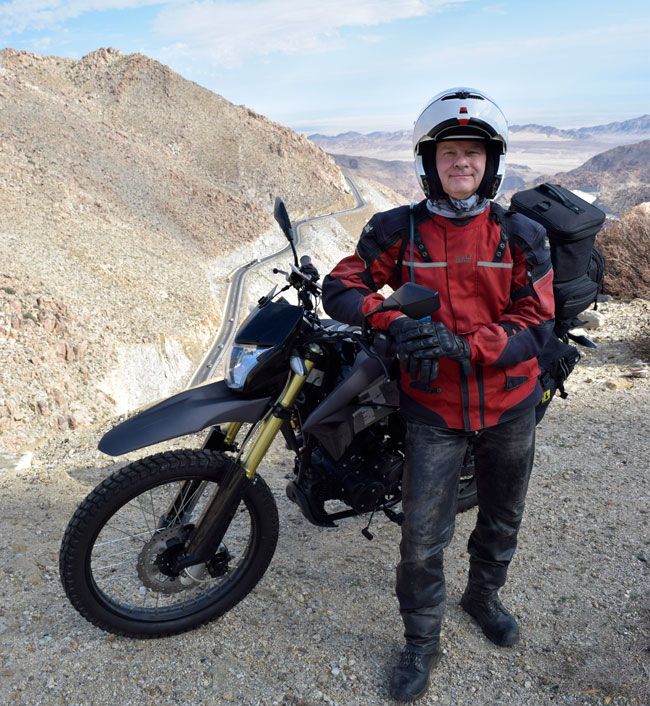
You might wonder why the first photo in a blog about the Royal Enfield Bullet is a CSC TT250. Let me explain. That guy in the photo above is good buddy Dan, with whom I’ve ridden in Baja a couple of times on the CSC trips (once on TT250s, and the other time on the RX3s). Dan is the only guy I know who owns an Enfield Bullet, and before I go into the good, the bad, and the ugly regarding my Bullet experience, I called him to get his take on the bike. Dan has owned his Bullet since 2013, it’s the fuel injected model (like the one I rode), and he has 7500 miles on it. Lest you think Dan doesn’t ride much, he owns several motorcycles, and that’s why he only has 7500 miles on his Enfield.
Dan told me his Bullet has been trouble free, but he also told me he is fastidious in maintaining it and he is a conservative rider. Dan said things vibrate loose and you have to keep an eye on that, but his bike has never broken down, it’s never had any electrical issues (like the missing and stumbling Joe Gresh and I experienced on the entire Baja trip), and he likes the bike. That’s good input, and it’s what I hoped I would hear.
For reasons I’ll explain later, I asked Dan about the rear sprocket and chain maintenance, and he laughed. “It’s the only thing I was going to mention,” Dan said. He replaced his rear sprocket at 7500 miles, and he is a fanatic about chain maintenance and lubrication. More on that in a bit, folks.
Another bit of background up front. Royal Enfield North America was kind enough to lend Joe and I a Bullet. Our particular bike was a 2016 press bike that had been stored at a dealer for some time (not Southern California Motorcycles, but another Enfield dealer), and when we received it, it was in a state of extreme neglect. I won’t go into that in detail (you can read about it in a prior blog); I’ll just mention it again and touch on it a few times through this post. The Enfield Bullet is an old school bike and it requires maintenance; this one had essentially none and it put a damper on our trip. I wanted to love the bike and write great things about it; the condition of the bike made that difficult.
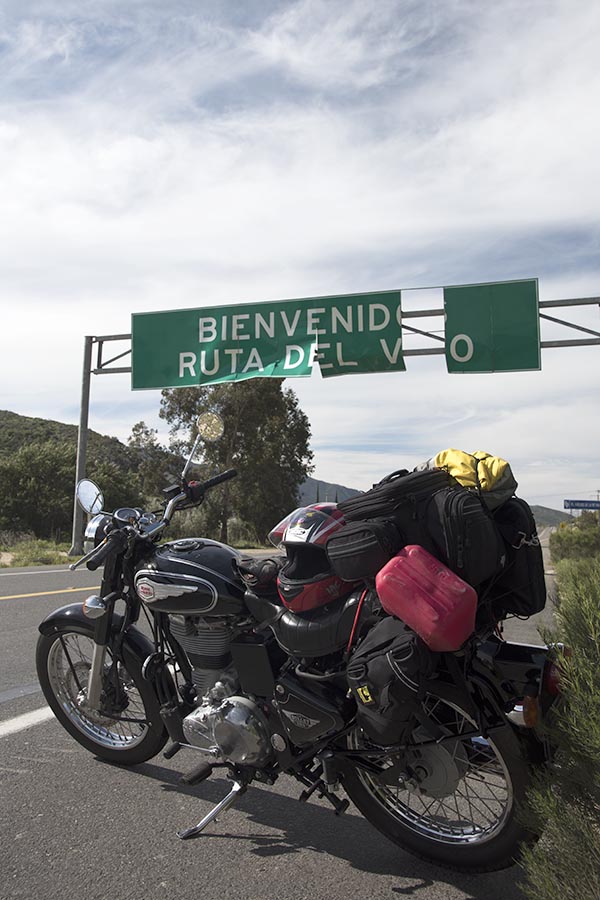
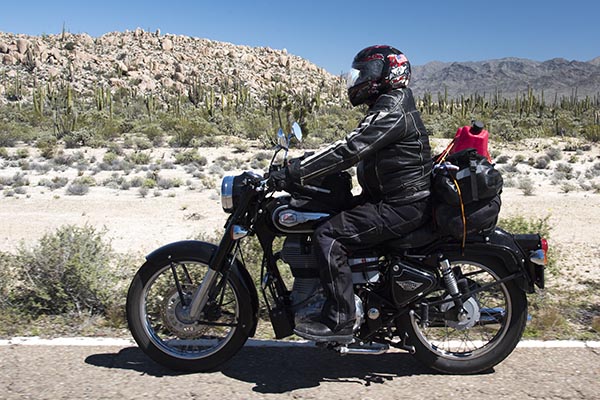
With that as a backdrop, let’s get into a detailed review.
I think the Bullet is a beautiful motorcycle. It has a look I just love. It screams 1950s, it screams British, and I love the feel and sound of a big single. The black paint and chrome work for me. The pinstriping is superb, and I found a video that shows how Royal Enfield does it…
The centerpiece of any motorcycle has to be the engine, and on this count, the Bullet excels. That beautiful, tall, exquisitely-finned single and its polished cases can only be described as stunning. It’s what a motorcycle is all about. No water-cooled, take-the-fairings-off-and-I-look-like-a-washing-machine silliness here. Nope. This is a motorcycle, with the accent on motor. I love the look.
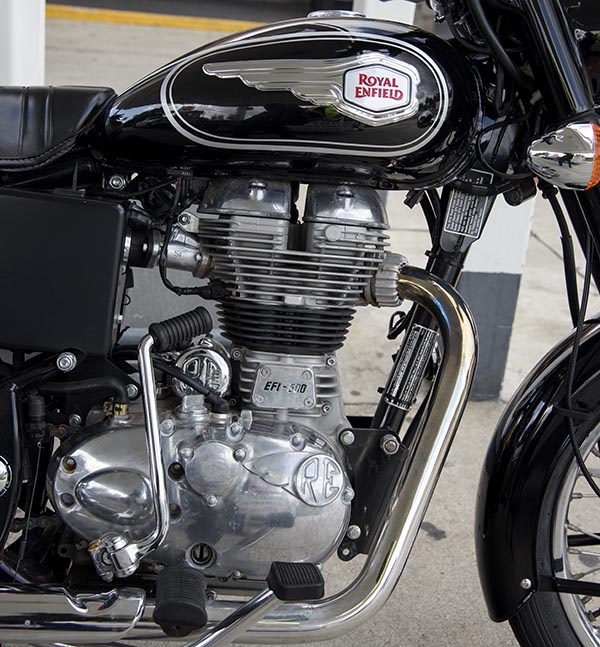
The Bullet’s fenders are enormous, deeply-valanced metal structures. They have a very 1950s look, which I like. No plastic here, folks. Curiously, the rear fender was not centered on the rear tire when viewed from behind. The wheels were aligned and the bike tracked true. My take is that the tolerance build up and assembly technique allowed the mismatch. My old 1978 Triumph Bonneville suffered from the same cosmetic issue.

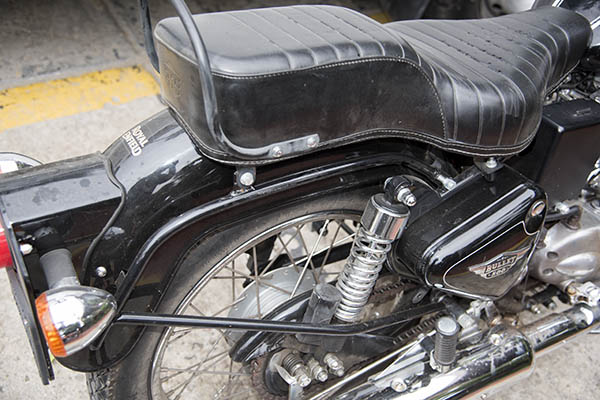
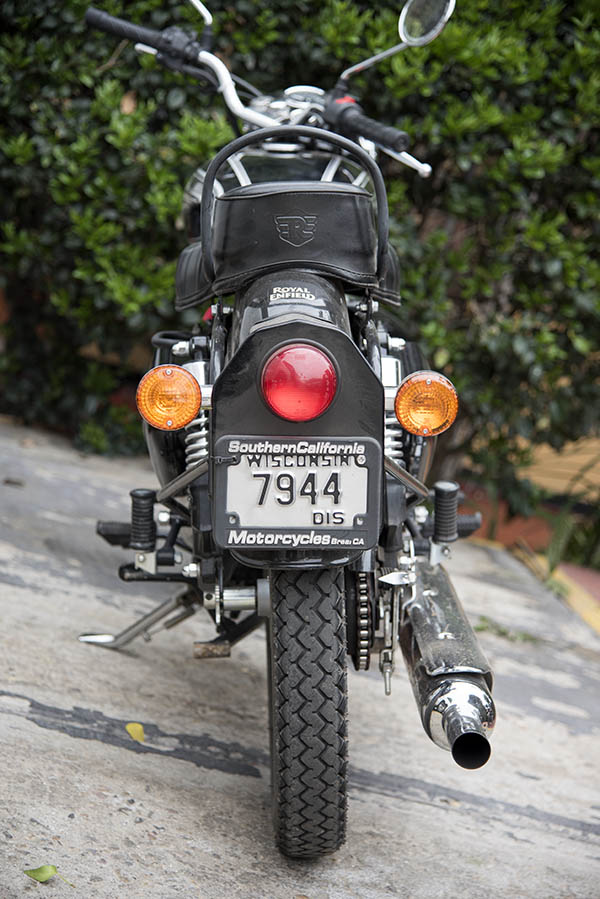
The front brake is good. It’s a disk brake and it stops well. The rear brake on the 2016 model I rode was a drum brake, which was adequate but not great. The newer Enfield 500s have ABS and a disk brake in back. I didn’t attempt to get the brakes to fade. That sort of whackadoodle stuff is best left to the mainstream moto media journalists as they flog bikes and overuse catchy phrases like “the controls fell easily to hand…” (that’s Gresh’s line; I wished I had thought of it). The brakes worked fine for us.
The Bullet comes with a decent tool kit (that’s the good news), which we actually had to use several times in Baja (that’s the bad news). It’s stored in a key-locked metal container on the left side of the bike. There’s a similar key-locked metal container on the right, and it provides access to the air cleaner.
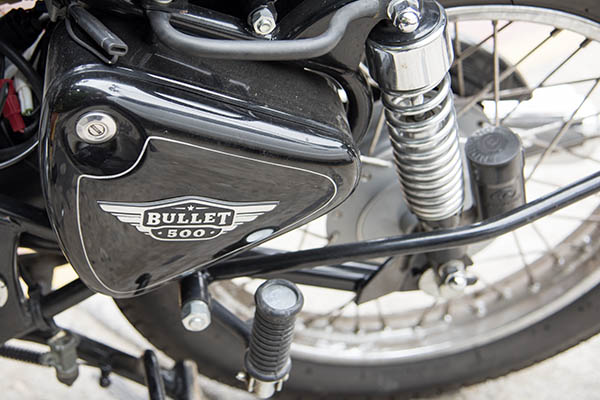
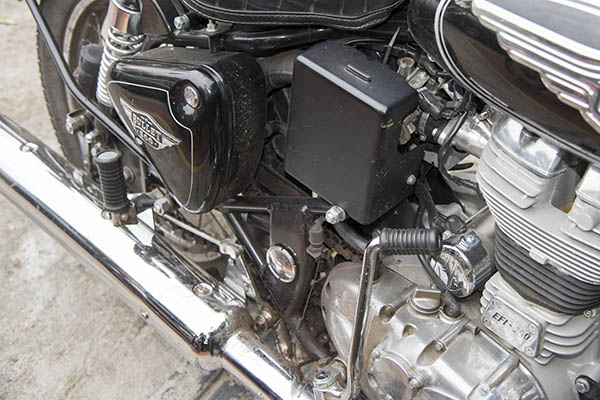
There’s another key-locked metal cover on the left side of the bike covering the battery, and that’s another good news story. The battery is big, and the terminals are accessible even with the cover on. That makes good sense. On our press bike, the battery was shot when we received the bike (we didn’t know that before we left for Mexico, though) and we had to buy a new battery in Guerrero Negro. We bought it at a tiny shop tucked away on a dirt road, and as you can imagine they didn’t stock Royal Enfield parts. We bought one that was close enough in size to go into the bike (but we couldn’t put the battery cover back on after installation). It worked just fine. Like they say, halitosis is better than no breath at all.
The Bullet has a kick starter. It looks cool, but the big single is tough to kick over. Both Gresh and I failed to start the bike with the kick start. I view the kick starter as more ornamental than functional. The electric starter works well, although our bike would go through several crankshaft rotations before it fired up. It was kind of like starting an old radial-engine airplane. It would get the engine turning, somewhere in there a little British chap yelled CONTACT, and then the engine would run on its own.
The wheels and tires on the Enfield are another old school touch. They’re both 19 inchers, with a 3.25×19 in front and 3.50×19 in the rear. Both have old-school tread designs. Both felt secure on the road and in the dirt, their narrow treads notwithstanding.


The fuel cap was not attached to the fuel tank, and it was the kind you completely unscrew. The Enfield website says the Bullet’s fuel tank holds 3.5 gallons. On the long stretch from Catavina to the Pemex station 20 miles north of Guerrero Negro (a distance of exactly 110 miles) the low fuel light indicator was just starting to flicker about 100 yards shy of the gas station. I don’t know for sure how many miles are left when that happens, but with a published capacity of 3.5 gallons, I suspect that like most fuel injected bikes, the low fuel light comes on early. Motorcycle manufacturers do that to keep the fuel pump immersed in fuel (it’s how the fuel pump is cooled). The Bullet’s fuel economy was superior. Gresh got just over 75 mpg riding it down to the border, and I got 72.something riding it north from the border. With that kind of fuel economy, I’m guessing that when the low fuel light comes on there’s still a good two gallons left in the tank.
At first, I thought the Bullet’s horn was tragic. It bleated like a baby lamb (sitting on the motorcycle, I could hear it, but no one else could). Then the battery died, and like I explained above, by the grace of God we found a useable replacement in Guerrero Negro. With the new battery the horn flat out honked. It’s a good horn, one that speaks with the authority a proper 500cc thumper should have.
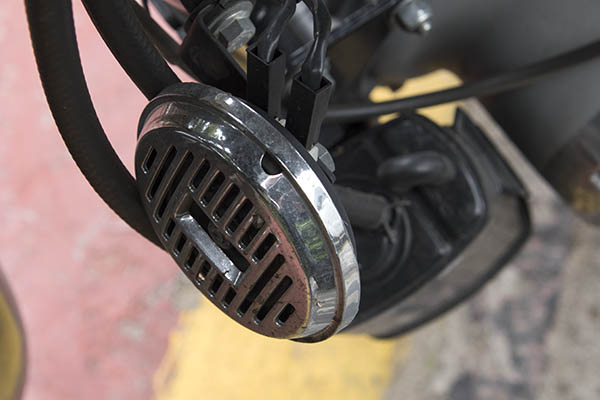
Instrumentation can only be described as primitive. Adequate would be stretching the word. There’s a speedometer and an odometer, but no tripmeter. There’s no tach, but the engine speeds were low enough that you could almost calculate rpm by counting thumps and using a wristwatch. There’s a fuel warning light but no fuel gage. That makes for dicey riding. You either have to hope the fuel warning light leaves enough range to make the next gas station (very dicey in parts of Baja), or you need to remember the odometer reading when you last filled up (very dicey at my age), or you need to ride with someone who has a trip meter on their bike (very dicey unless you know people in high places in Royal Enfield North America, like I do). There’s a check engine light (which is kind of funny, because like I explained at the beginning, this motorcycle is all motor…yep, the engine’s there alright!), there’s a turn signal indicator (which I never could see in the daytime), there’s a high beam indicator (can’t see it in the daytime), and there’s a neutral light (same story, you just can’t see it during the day). One other mild concern for me was that when I cruised between 55 and 65 mph (the Enfield’s sweet spot), the speedo needle obscures the odometer and I could not tell how far I’d ridden when I tried to use the odometer as a fuel gage.
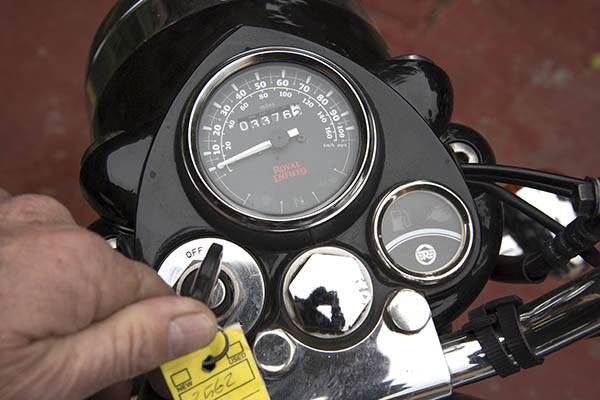
The Bullet has both a centerstand and a kickstand, and it was easy to deploy both. On our ride, after the third day I was sure the bike was leaning more to the left than it had been on the kickstand. Gresh looked at it and he started laughing. It sure was. The thing leaned further left than Bernie Sanders. The sidestand and the left footpeg are bolted to a metal plate, which is in turn bolted to the frame. That plate was bending. Gresh deployed the sidestand and stood on it, which bent the mounting plate back to a more reasonable position. We thought we were good until the bike died on the road a short while later. It didn’t start missing or stumbling this time; it just died as if someone had turned the ignition off. Here’s why: The kickstand actuates a “kickstand down” switch, which prohibits engine operation if the kickstand is extended (sort of; bear with me on this part of the story).
We had another failure the morning we left Guerrero Negro, and it was one of those sudden “ignition off” failures. Joe unbolted the kickstand interlock switch by the side of the road out there in the Baja desert and we did a quick test to find out if the switch needs to be open or closed to allow engine operation. We quickly concluded it is a normally-closed switch, and then we simply ziptied the switch to the frame after removing it from the kickstand mounting plate. From that point on, our easy-to-fool Bullet thought the kickstand was always up. Problem solved; no more engine sudden death syndrome. Yeah, things were going south, but in its defense, problems on the Bullet are easy to diagnose and fix.

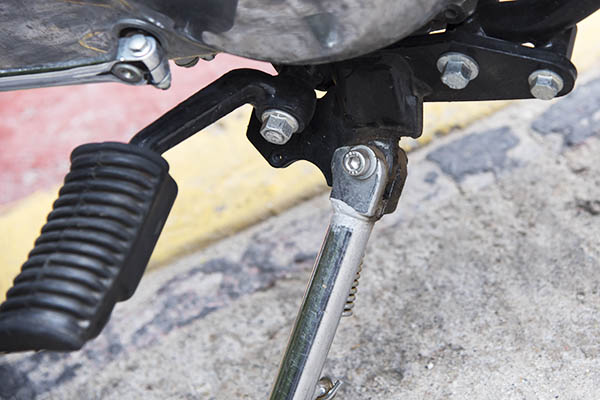
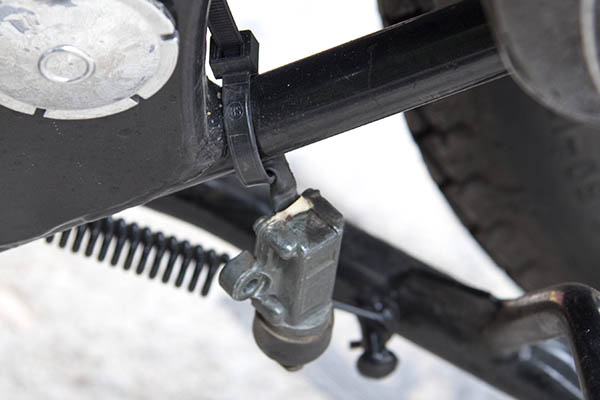
The plate securing the kickstand is either underdesigned (i.e., it’s too weak), or the metal was improperly heat treated and it’s too soft. In the bike’s defense, I was carrying about 50-60 lbs of stuff in my Wolfman bags and Nelson-Rigg tailpack, and I have a habit of standing on the left footpeg and throwing my right leg over the luggage when I get on a bike. That puts a strain on the kickstand and its mount. But that’s a likely scenario for any rider, and the bike should have been able to take it without the kickstand mounting plate bending.
One more thing on the kickstand switch…the logic is weird. With the bike on the sidestand, you can crank the engine all you want. It just won’t fire. Consequently, you can’t idle the bike to let it warm up on the kickstand (if the bike is running, as soon as you extend the kickstand, the engine dies). But you can crank the starter with the bike on the kickstand. I think that’s dumb, because it will allow you to propel the bike forward on the kickstand if the bike is in gear. On most bikes, with the kickstand down you can’t crank or run the motorcycle. That’s how I would do it, but then, I don’t sell a zillion bikes a year like Royal Enfield does, so what do I know?
I found the Bullet to be surprisingly comfortable, more so even than the Interceptor and most other motorcycles. The seat was hard and the step in it prevents moving around during long hours in the saddle, but the ergonomics worked for me. Gresh said the same thing. The bike doesn’t have a fairing or a windshield, but it was supremely comfortable at any speed.
Suspension, front and rear, is non-adjustable on the Bullet. It’s not an issue for me. Stack 20 mattresses, put a pea underneath the mess, and I can’t tell you if that pea is there or not. For me, adjustable suspension is the same sort of thing. I think the entire concept of adjustable suspension for most folks is a joke (particularly suspension dampening), little more than a marketing gimmick. I’ve had bikes with adjustable suspension that I rode for years and I never changed the factory suspension settings. Your mileage may vary. I don’t know the suspension travel, but whatever it is, I found it to be sufficient. I carried a lot of freight on the Bullet over roughly 1300 Baja miles and I never bottomed out.
The Bullet’s top speed was somewhere in the indicated 72-73 mph range. The bike had enough power for passing, but just barely. Again, for the kind of riding I do, it was adequate. On the US freeways down to Mexico, we ran at about 60-65 mph, we stuck to the right lane, and we were fine. Enfield advertises 27 horsepower for this motorcycle, and that figure sounds about right. My 250cc Zongshen RX3 has 25 horsepower, it’s a little lighter, and it’s a little faster. But I recognize that nobody buys the 500cc Enfield to race other motorcycles. I suspect the people who buy this bike don’t care about 0-60 times or top speeds. It’s all about the vintage riding experience, and in that regard, the Enfield excels.
The Bullet frame is a massive tubular steel affair, like they made them when men were men and well, you get the idea. On some of the rear portions of the frame, the tube diameter was so large my bungee cord hooks wouldn’t fit. The Bullet has these sort of frame runners that go outside the bike on either side in the rear; those were very handy for bungee cord hookups.
On the ride home, with 20 miles to go at the end of our trip, the Bullet started misbehaving big time. It was clanking and banging, so much so that I initially thought I had thrown a rod or toasted a main bearing. Nope, it wasn’t that at all. We hit a bit of rain, and even though we had lubed the chain that morning and found it to be sufficiently tight, it was bone dry from the rain and it was hopping over the rear sprocket. The chain was already rusty, and the rear sprocket teeth were rounded and hooked. In under 3500 miles. Amazing. That’s what my good buddy Dan laughed about when I called him earlier. His take on it is that Enfield uses a very cheap and soft rear sprocket. That and the neglectful dealer’s lack of maintenance on our Bullet combined to toast the chain, the rear sprocket, and probably the front sprocket. In defense of the Bullet, it got me home, but the last few miles of our trip were at 10 mph or less.
As I stated at the beginning of this blog, and as Joe and I talked about in previous blogs, the dealer who had this bike did nothing we could see to maintain it, and they certainly did nothing to prep the bike for our Baja trip. When the Bullet was delivered, the oil was a quart down, the chain was rusty, the spark plug wire and lead were corroded, and the battery was on its last legs. Before the bike was delivered, I called the dealer to ask if the Bullet had a tool kit, and the salesperson I spoke with became defensive. Like Steve Martin used to say, well, excuuuuse me. The bike was a press bike, and it probably was abused by others writing about, you know, the controls falling easily to hand and such (and maybe doing burnouts and wheelies), but there was just no excuse for the bike to be delivered in the condition it was in. It only had 2264 miles on the odometer when we got it. Royal Enfield was apologetic and embarrassed by all of it; the dealer should be ashamed. I think that was a major screwup on their part. Maybe they just don’t care, or perhaps they’re too busy finding new ways to inflate ADM fees and overcharge for desmodromic valve adjustments. Whatever. I’ll never buy a motorcycle from them. On the other hand, the dealer who provided the Interceptor (Southern California Motorcycles) delivered that bike in perfect condition. That’s the way it’s supposed to be.
The Bullet dealer’s failure to prep the 500 was unfortunate. I really wanted to love the thing and maybe buy one, but I can’t after what we experienced. That’s a shame. The Bullet reminded me of my ’92 Harley Softail in many ways. It was a paint-shaker at speed, it was okay on the freeway, it excelled on country roads, and it looked, felt, and sounded like a motorcycle should.
The last topic I’ll touch on is the Bullet’s pricing. For whatever reason, I thought the Bullet’s MSRP was around $4795, but I was off by nearly a thousand bucks. A new Enfield 500 is $5599, and that’s before the fiction dealers call freight and setup. A new 650 Interceptor is $5799. To me, that’s nuts. For an extra two hundred bucks, the Interceptor is just too much motorcycle to pass up. Maybe Enfield is going to phase out the 500. Or maybe the Bullet just costs that much to make (which I think is very, very unlikely, as any Bullet tooling or other fixed costs were probably amortized before most of the folks reading this were born). I like the Bullet enough to consider going the Joe Gresh route (you know, buy a used one for cheap). But a nationwide search on CycleTrader showed almost no used Bullets for sale, and the few that were listed were close enough to a new bike’s price that their owners (in my opinion) were dreaming. Go figure. I guess folks who own these bikes just don’t sell them, and I think that speaks well for the bike.
You might be wondering…why did we take a 2016 Bullet instead of a 2019 new Enfield 500? Hey, you go to war with the Army you have, and the 2016 Bullet is what the good folks at Royal Enfield North America gave to us. I don’t know if some of the things I’m writing about have been addressed in newer versions. Maybe it’s not fair to do a road test on a bike that’s already 3 years old, but if there’s any unfairness here, it’s in the fact that the bike was just flat neglected, and that’s something we had no control over.
So there you have it. Neglected or not, the Bullet got us down to Guerrero Negro and back, and it took us to see our friends in Scammon’s Lagoon. The whale watching this year was awesome…some of the best I’ve ever experienced.
Next up? Our take on the new Interceptor. That’s really exciting, both because it’s a new model and to my knowledge we are the first folks in the US to take the new 650 Enfield on a real adventure ride.
Stay tuned, my friends…

Great editorial our local Indian dealer has some I’ll get up and check them out
“halitosis is better than no breath at all.” Ha! That’s good stuff!
Great write-up Joe. I’d just like to add a couple of things.
My 2012 model has never broken down, but I did have an issue twice where the negative battery lead broke due to the Bullet’s vibey nature. The second time I replaced it with a fatter gauge wire and haven’t had trouble since.
I’ve had good luck starting the bike with the kick starter. It always takes about 2 or 3 kicks however, and you have to wait a second between kicks as you can hear the fuel pump prime the system to pressure after each kick. Bullet owners have to keep in mind that kick starter or not, your battery has got to have enough juice to run the fuel pump.
I have no idea why they didn’t include a trip odometer in that instrument gauge. Really weird. I got in the habit of keeping a sharpie in my jacket pocket and I just write the mileage at fill-up time on the chrome fork plate. Wipes off with spit.
FYI, the “check engine” light is also a troubleshooting device (If you know the blink codes).
I’m happy with my Bullet. It’s taken me all over Colorado, New Mexico, Wyoming, and Utah. I looked at the new RE Himalayan a couple of months ago (With the new long stroke motor) and I’d have one if its niche wasn’t already filled by the CSC RX-3. Those new 650 twins though . . . Very tempting.
Cheers,
Dan K.
Thanks much, Dan. We need to do another Baja ride!
Thanks for another great write up Joe. It was enlightening, following along with you two. really like your style.
You bet, Duane. Info on the Interceptor to post tomorrow. We had a great time in Baja.